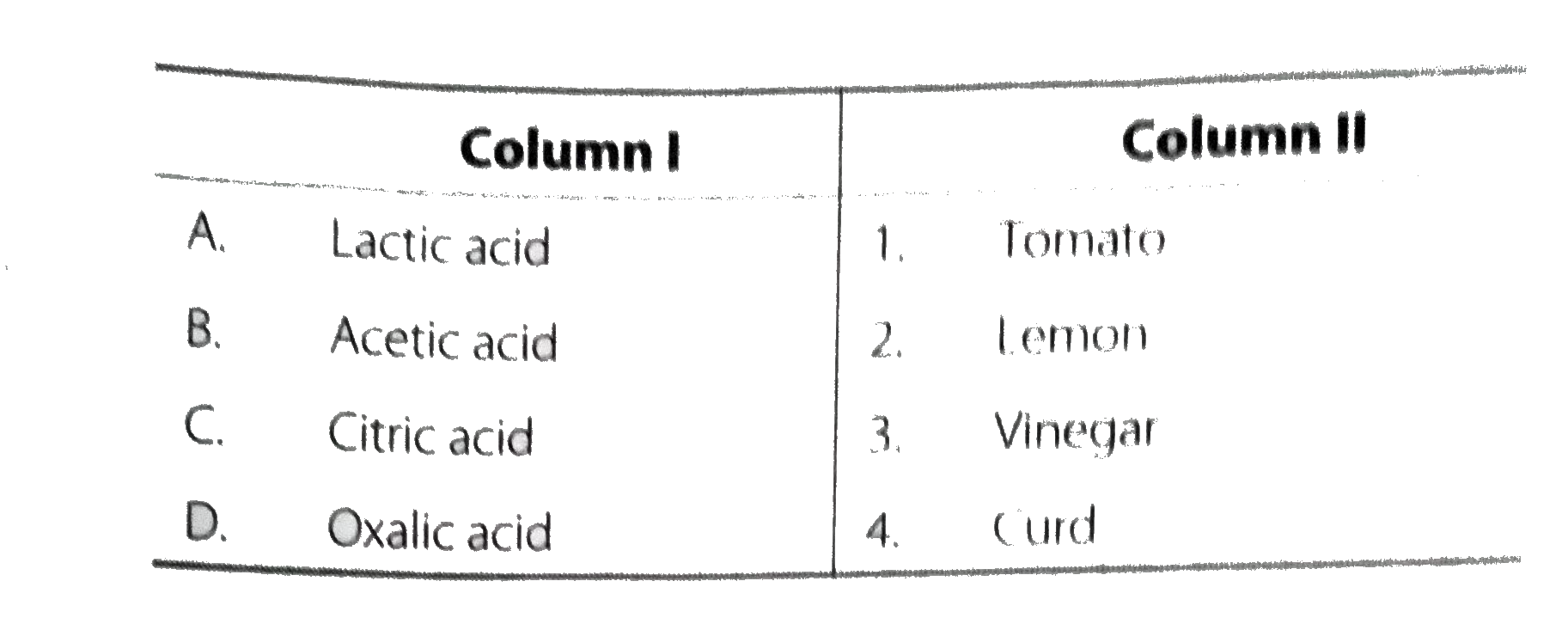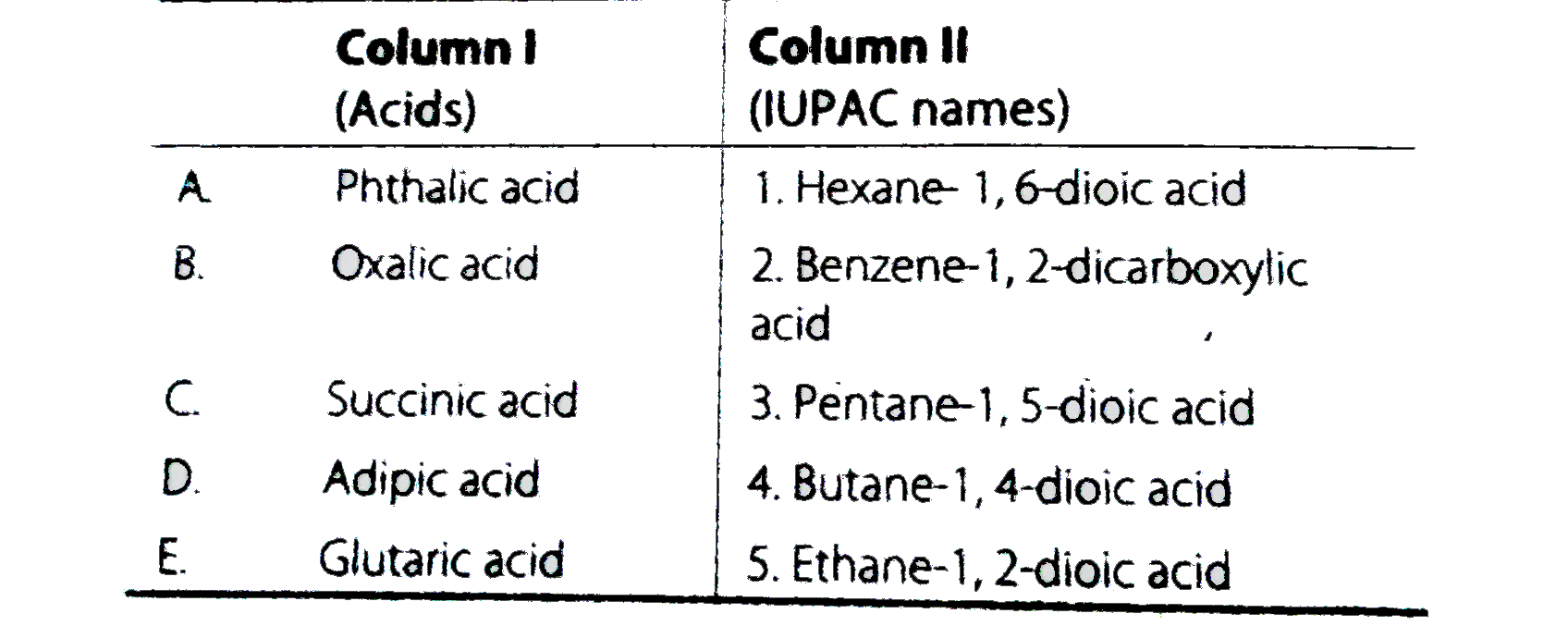Match the compounds listed in column I with characteristic listed in column II.
Column-IColumn-II(A)Hypophosphorus acid(p)All hydrogen are ioniasable in water(B)Orthoboric acid(q)Monobasic acid(C)Hypophosphoric acid(r)sp3hybridised central atom(s)(D)Pyrosulphurous acid(s)Lewis acid(t)Central atom contains one lone pair of electrons
The correct Answer is:A-q,r ; B-q,s ; C-p,r ;D-p,r,t
To solve the problem of matching the compounds listed in Column I with the characteristics in Column II, we will analyze each compound and its properties step by step.
Step 1: Analyze Hypophosphorus Acid (H₃PO₂)
- Formula: H₃PO₂
- Characteristics:
- (p) All hydrogen are ionizable in water: False. Only one hydrogen is acidic.
- (q) Monobasic acid: True. It has only one ionizable hydrogen.
- (r) sp³ hybridized central atom(s): True. Phosphorus in H₃PO₂ has four sigma bonds (three with hydrogen and one with oxygen).
- (s) Lewis acid: False. It does not have a vacant orbital to accept electrons.
- (t) Central atom contains one lone pair of electrons: False. Phosphorus does not have a lone pair in this structure.
Matching for A: (q) and (r)
Step 2: Analyze Orthoboric Acid (H₃BO₃)
- Formula: H₃BO₃
- Characteristics:
- (p) All hydrogen are ionizable in water: False. Not all hydrogens are acidic.
- (q) Monobasic acid: True. It can donate one proton.
- (r) sp³ hybridized central atom(s): False. Boron is sp² hybridized due to three sigma bonds.
- (s) Lewis acid: True. Boron can accept an electron pair.
- (t) Central atom contains one lone pair of electrons: False. Boron has no lone pairs.
Matching for B: (q) and (s)
Step 3: Analyze Hypophosphoric Acid (H₄P₂O₆)
- Formula: H₄P₂O₆
- Characteristics:
- (p) All hydrogen are ionizable in water: True. All four hydrogens can ionize.
- (q) Monobasic acid: False. It has four ionizable hydrogens.
- (r) sp³ hybridized central atom(s): True. Both phosphorus atoms are sp³ hybridized.
- (s) Lewis acid: False. It does not have vacant orbitals.
- (t) Central atom contains one lone pair of electrons: False. Phosphorus does not have lone pairs.
Matching for C: (p) and (r)
Step 4: Analyze Pyrosulphurous Acid (H₂S₂O₅)
- Formula: H₂S₂O₅
- Characteristics:
- (p) All hydrogen are ionizable in water: True. Both hydrogens can ionize.
- (q) Monobasic acid: False. It has two ionizable hydrogens.
- (r) sp³ hybridized central atom(s): True. The sulfur atoms are sp³ hybridized.
- (s) Lewis acid: False. Sulfur does not have vacant orbitals.
- (t) Central atom contains one lone pair of electrons: True. Sulfur has a lone pair.
Matching for D: (p), (r), and (t)
Final Matching Summary:
- A: (q), (r)
- B: (q), (s)
- C: (p), (r)
- D: (p), (r), (t)
- Formula: H₃PO₂
- Characteristics:
- (p) All hydrogen are ionizable in water: False. Only one hydrogen is acidic.
- (q) Monobasic acid: True. It has only one ionizable hydrogen.
- (r) sp³ hybridized central atom(s): True. Phosphorus in H₃PO₂ has four sigma bonds (three with hydrogen and one with oxygen).
- (s) Lewis acid: False. It does not have a vacant orbital to accept electrons.
- (t) Central atom contains one lone pair of electrons: False. Phosphorus does not have a lone pair in this structure.
- Formula: H₃BO₃
- Characteristics:
- (p) All hydrogen are ionizable in water: False. Not all hydrogens are acidic.
- (q) Monobasic acid: True. It can donate one proton.
- (r) sp³ hybridized central atom(s): False. Boron is sp² hybridized due to three sigma bonds.
- (s) Lewis acid: True. Boron can accept an electron pair.
- (t) Central atom contains one lone pair of electrons: False. Boron has no lone pairs.
- Formula: H₄P₂O₆
- Characteristics:
- (p) All hydrogen are ionizable in water: True. All four hydrogens can ionize.
- (q) Monobasic acid: False. It has four ionizable hydrogens.
- (r) sp³ hybridized central atom(s): True. Both phosphorus atoms are sp³ hybridized.
- (s) Lewis acid: False. It does not have vacant orbitals.
- (t) Central atom contains one lone pair of electrons: False. Phosphorus does not have lone pairs.
- Formula: H₂S₂O₅
- Characteristics:
- (p) All hydrogen are ionizable in water: True. Both hydrogens can ionize.
- (q) Monobasic acid: False. It has two ionizable hydrogens.
- (r) sp³ hybridized central atom(s): True. The sulfur atoms are sp³ hybridized.
- (s) Lewis acid: False. Sulfur does not have vacant orbitals.
- (t) Central atom contains one lone pair of electrons: True. Sulfur has a lone pair.
- A: (q), (r)
- B: (q), (s)
- C: (p), (r)
- D: (p), (r), (t)
Topper's Solved these Questions
Similar Questions
Match the acids given in Coplumn I with their correct source given in column II
 View Solution
View SolutionMatch the complexes in Column-I with characteristic(s)/ type of hybridisation listed in column-II
 View Solution
View SolutionMatch the acids given in Column I with their correct IUPAC names given in Column II.
 View Solution
View SolutionMatch the compounds listed in column I with characteristic listed in column II.
Column-IColumn-II(A)SF2(p)sp3and bent(B)KrF4(q)Lone pair(C)NOCl(r)Bond angle less than109∘28'(D)N(Me)3(s)sp2and bent(t)sp3d2and square planarView SolutionMatch the compounds listed in column I with characteristic listed in column II.
Column-IColumn-II(A)B2H6(p)Tetrahedral hybridisation(B)Al2Cl6(q)Trigonal planar hybridisation(C)BeCl2(s)(r)Empty orbital of central atom participate in hybridisation(D)(SiH3)3N(s)Two types of bonds(t)Two type of bond anglesView SolutionMatch the compounds listed in column I with characteristics type of reaction listed in column II.
Column IColumn II(A)XeF2(p)Undergoes hydrolysis with water(B)XeF4(q)Acts as oxidising agent(C)XeF6(r)Undergoes addition reaction(D)XeO3(s)has lone pair of electrons(t)Gives disproportionation reaction with H2OorOH−View SolutionMatch the compounds listed in colomn-I with the related uses/particulars listed in column-II.
Column IColumn II(A)Calcium hypochlorite(p)Used as air purifier in submarine(B)Calcium suphate hemi hydrate(q)Used for 'softening' water(C)Potassium super oxide(r)A constituent of bleaching powder(D)Calcium oxide(s)Plaster of Paris(t)Used in preparation of sodium hydroxide.View SolutionMatch the compounds, listed in column-I with the characteristic(s) listed in column-II.
Column IColumn II(A)BeO(s)(p)Amphoteric in nature(B)NaHCO3(crystalline)(q)Imparts characteristic colour to Bunsen flame(C)BeCl2(s)(r)ProduceH2O2andO2on reaction with water.(D)CsO2(s)(s)Show hydrogen bonding(t)Has a chain structureView SolutionMatch the extraction processes listed in Column I with metals listed in Column II.
Column IColumn II(A)Self reduction(p)Lead(B)Carbon reduction(q)Silver(C)Complex formation and displacement by metal(r)Copper(D)Decomposition of iodide(s)BoronView SolutionMatch the shape of molecules in Column 1 with the type of hybridisation in Column II.
Column IColumn II(a)Tetrahedral(i)sp2(b)Trigonal(ii)sp(c)Linear(iii)sp3(d)Trigonal bipyramidal(iv)sp3dView Solution

